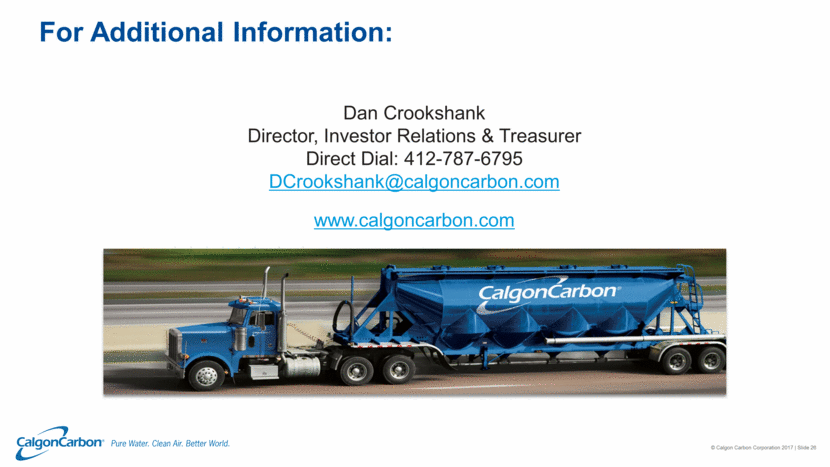Attached files
| file | filename |
|---|---|
| 8-K - 8-K - CALGON CARBON Corp | a17-8178_18k.htm |
Exhibit 99.1
March 13, 2017 Calgon Carbon Corporation Investor Presentation 29th Annual ROTH Investor Conference
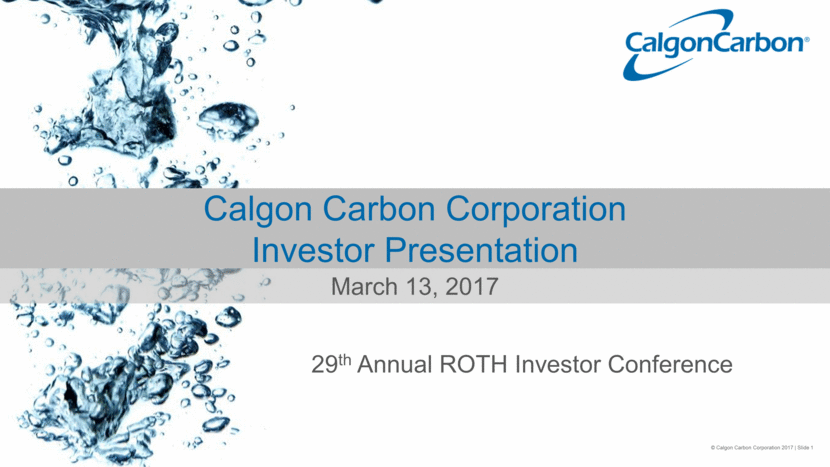
Forward Looking Statement This presentation contains historical information and forward-looking statements. Forward-looking statements typically contain words such as “expect,” “believe,” “estimate,” “anticipate,” or similar words indicating that future outcomes are uncertain. Statements looking forward in time, including statements regarding future growth and profitability, price increases, cost savings, broader product lines, enhanced competitive posture and acquisitions, are included in this presentation pursuant to the “safe harbor” provision of the Private Securities Litigation Reform Act of 1995. These forward-looking statements involve known and unknown risks and uncertainties that may cause Calgon Carbon Corporation’s (the Company’s) actual results in future periods to be materially different from any future performance suggested herein. Further, the Company operates in an industry sector where securities values may be volatile and may be influenced by economic and other factors beyond the Company’s control. Factors that could affect future performance of the Company include, without limitation: the Company’s ability to successfully integrate the November 2, 2016 acquisition of the assets and business of the wood-based activated carbon, reactivation, and mineral-based filtration media of CECA, a subsidiary of Arkema Group (the New Business) and achieve the expected results of the acquisition, including any expected synergies and the expected future accretion to earnings; changes in, or delays in the implementation of, regulations that cause a market for our products; changes in competitor prices for products similar to ours; higher energy and raw material costs; costs of imports and related tariffs; unfavorable weather conditions and changes in market prices of natural gas relative to prices of coal; changes in foreign currency exchange rates and interest rates; changes in corporate income and cross-border tax policies of the United States and other countries; labor relations; availability of capital and environmental requirements as they relate to both our operations and to those of our customers; borrowing restrictions; validity of patents and other intellectual property; and pension costs. In the context of the forward-looking information provided in this presentation, please refer to the discussions of risk factors and other information detailed in, as well as the other information contained in the Company’s most recently filed Annual Report. Any forward-looking statement speaks only as of the date on which such statement is made and the Company does not intend to correct or update any forward-looking statements, whether as a result of new information, future events or otherwise, unless required to do so by the Federal securities laws of the United States. Non-GAAP Financial Data This presentation includes the use of EBITDA, a financial measure that is not in accordance with generally accepted accounting principles (“GAAP”). The Company defines EBITDA – which is a non-GAAP measure – as net income from its consolidated statements of comprehensive income before interest income, interest expense, income tax provision and depreciation and amortization. Since this is not a measure determined in accordance with GAAP, our definition may not be comparable to the calculation of similar measures by other companies. EBITDA should not be considered in isolation, as a superior measure to, or as an alternative measure to net income, income from operations, net cash provided by operating activities or other GAAP financial measures of operating performance or cash flow measures of liquidity. The Company has included EBITDA as a supplemental disclosure as it believes EBITDA provides useful supplemental information to investors regarding its ability to – among other things – service debt, pay dividends, and fund capital expenditures and because it uses the EBITDA metric as an element of its incentive compensation programs. Disclosure Statement
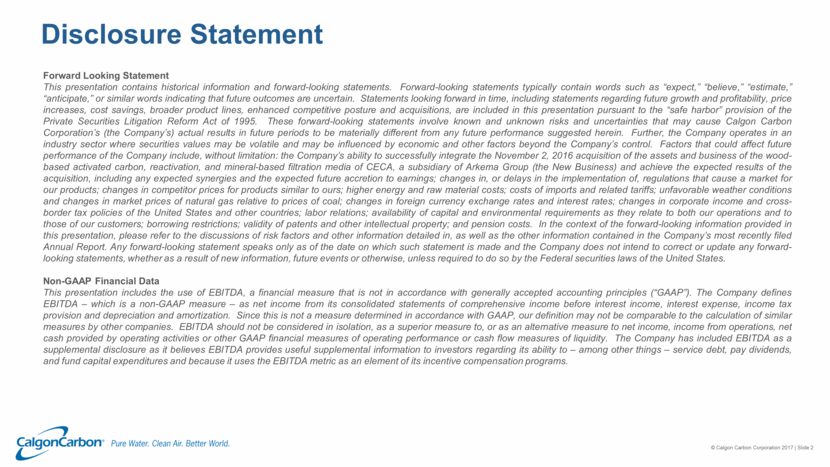
The world’s largest producer of granular activated carbon The most diversified provider of high quality activated carbon, filtration media, and services including equipment and carbon reactivation Clearly focused on high-end market segments with strong share positions A market leader in technical service and application development to support share positions and to capitalize on emerging contaminant treatment A company with 20 manufacturing and innovation facilities in 7 countries and global sales teams represented in 16 countries Calgon Carbon is
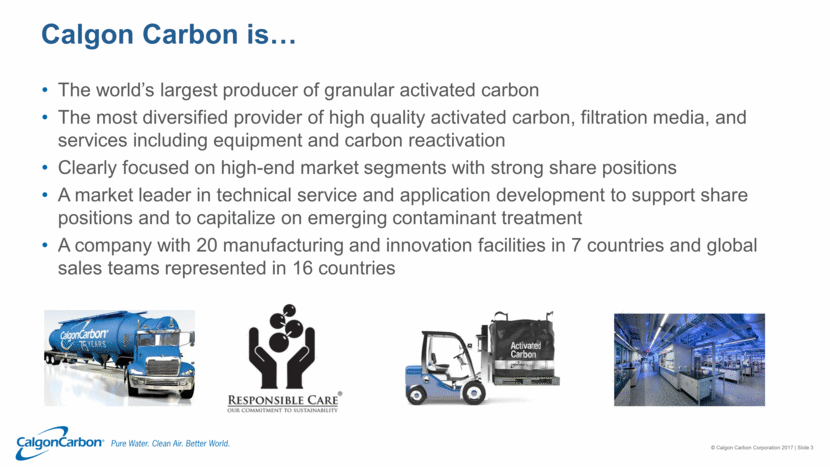
How Our Products Help Our Customers and Society Reduce environmental impact and allow waste water reuse or disposal Purify food products Protect your personal environment Provide clean, safe drinking water Protect global marine ecosystems from invasive species Remove and recover contaminants from air emissions Accelerate wound healing Enhance critical stages in chemical manufacturing
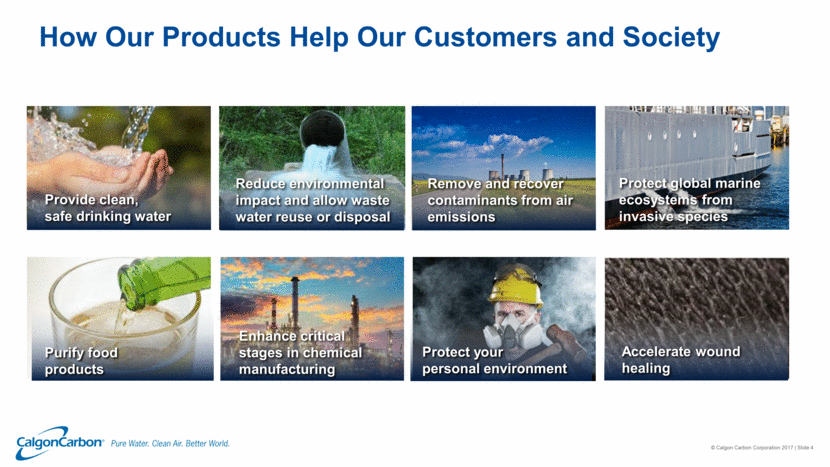
Net Sales by End Markets and Geography End Markets Geography * Includes industrial sector customers which collectively account for ~30% of net sales 2016 Pro Forma(1) Net Sales $601.2 Million (1) Assumes New Business had been acquired on January 1, 2016. See Note 20 in the Company’s 2016 Annual Report on Form 10-K. Americas 49% EMEA 35% Asia 16%
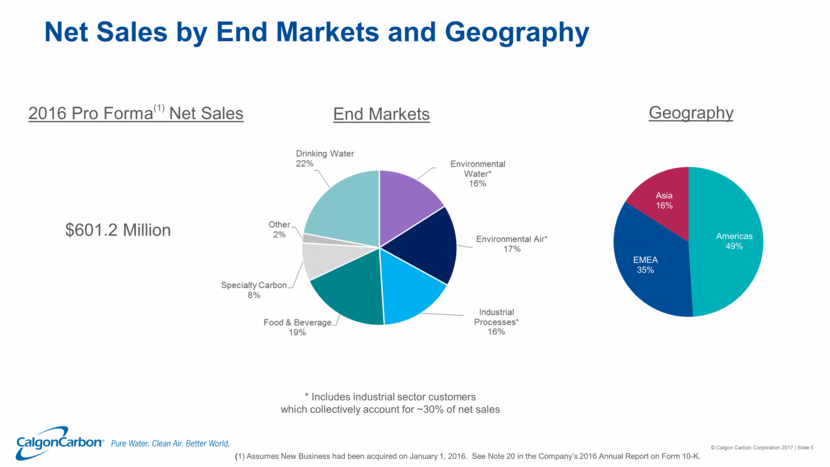
Global Presence Columbus, OH North Tonawanda, NY Pittsburgh, PA (HQ) Catlettsburg, KY Pearlington, MS Neville Island, PA Gila Bend, AZ Columbus, OH Blue Lake, CA Houghton-le-Spring, UK Ashton-in-Makerfield, UK Parentis-en-Born, France Suzhou, China Fukui, Japan Singapore (HQ) Findlay Twp. PA Global Sales Offices Manufacturing Locations Regional Offices / HQ Feluy, Belgium (HQ) Foggia, Italy Legnago, Italy Riom-es-Montagnes, France Saint-Bauzile France Tipton, UK
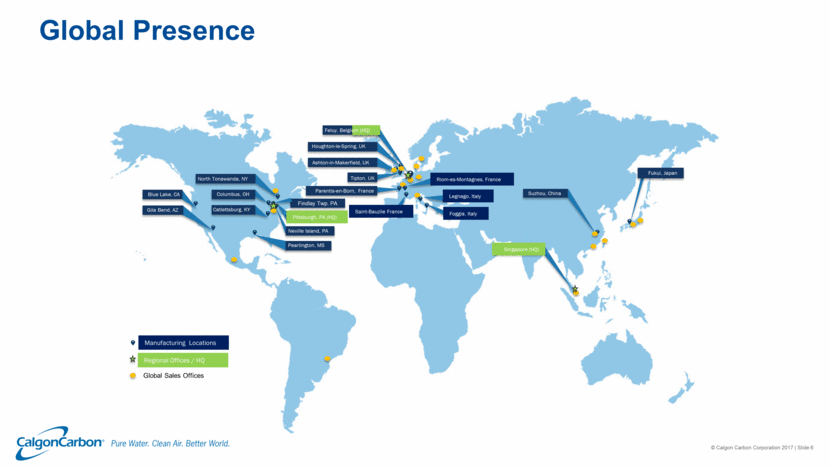
Manufacturing / commercial capabilities Virgin wood-based activated carbon Carbon reactivation services Diatomaceous earth (DE) and perlite filtration media Perliting / cryogenic insulation Strong end market customer relationships Beverage, food, industrial, pharmaceutical 40% of customer base uses both carbon and filtration media products Stable financial performance Solid market positions in EMEA region ~ 300 employees Virgin activated carbon Diatomaceous earth Perlite Business Description Operating Locations EBITDA Impact of Synergies and Projects ($/M) Parentis, France Legnago, Italy Riom Es Montagnes, France Saint-Bauzile, France Abidos, France Foggia, Italy Acquisition of Wood Activated Carbon and Filter Aid Business (New Business) Carbon reactivation Perliting/cryogenic insulation Transaction Highlights Transaction closed Nov. 2, 2016 Great strategic fit Diversifies exposure to regulatory and traditional end market growth opportunities Strengthens operations and market position in Europe Geographically extends carbon reactivation capacity into Southern Europe Value creation path – synergy capture and projects on track for realization by 2019 Is expected to contribute ~ $100 million in net sales in 2017 Expected to be accretive to fully diluted EPS in 2017 40% Improvement (2) (1) Using an exchange rate of €1.00 = $1.10 (2) Expected annual EBITDA contribution by 2019 (2) (1) $16.7 $23.4 $3.4 $3.3 0 5 10 15 20 25 2015 Integration Synergies In-progress Projects Pro Forma EBITDA
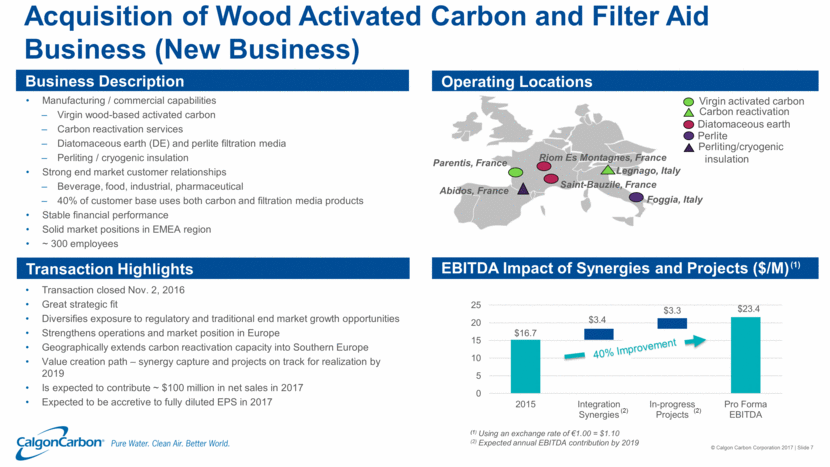
Product Portfolio Geography Primary Applications Bituminous coal-based activated carbon Granular, powder, extruded Americas Europe Asia Drinking water Wastewater Environmental air Industrial Food & beverage Wood-based activated carbon Europe Asia Food & beverage Industrial Pharmaceutical Diatomaceous earth filtration media (DE) Europe Asia Food & beverage Industrial Perlite filtration media Europe Beverage Industrial Fillers Carbon cloth Europe Americas Medical Defense Industrial Granular activated carbon reactivation North America Europe Asia Drinking water Wastewater Industrial Food Solve customer’s most demanding purification and separation problems Integrated offering of activated carbon, equipment, reactivation and field support Applications expertise in municipal, industrial, and food & beverage end markets Customer stickiness enabled by product quality, service and technical support Premium Activated Carbon and Filtration Media Products Address High-End Market Needs
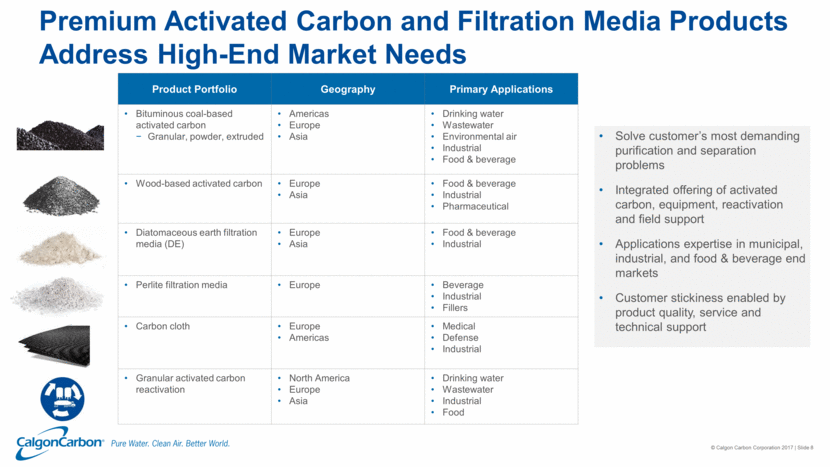
Innovative Equipment Addresses High-End Market Needs Carbon Adsorption Systems Ultraviolet Technology Ion Exchange Systems Ballast Water Treatment
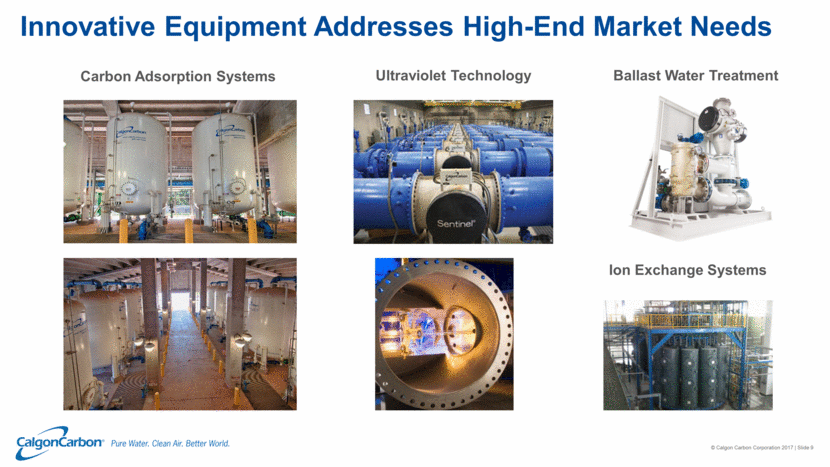
Diverse End Markets Served Purification and de-colorization of many foods and beverages, including corn syrup and cane sugar for sweetener manufacturers Filtering and purifying water, liquids, gases for use in brewing and bottling Removal of regulated and non-regulated contaminants, including disinfection byproducts (DBP) and perflourinated compounds (PFCs) Integrated offering combining GAC, reactivation, carbon adsorption equipment and field service creates competitive advantage FILTRASORB® GAC is a leading technology Ongoing discovery and growing public awareness of contamination in water sources globally Fast developing demand for PFC removal Pending regulation of 1,2,3-trichloropropane (1,2,3-TCP) in California, New Jersey and Hawaii Ongoing adoption of GAC to comply with DBP Stage 2 regulations Markets and demand remain relatively stable; customers looking to optimize carbon usage New Business(1) wood-based activated carbon and DE and perlite filtration media adding to end market volumes Leading supplier of specialty carbons to gas mask manufacturers for the U.S. and European military, and respirators for first responders and others Recovery of precious metals Anticipated increase in U.S. military spending Recently secured new 5-year contract for respirator carbon products with existing customer Expected sales of ~$6 million per year (1) New Business refers to the wood-based activated carbon, reactivation and filter aid business acquired on November 2, 2016. Drinking Water Food & Beverage Specialty Carbons Capabilities / Applications Market Trends / Drivers
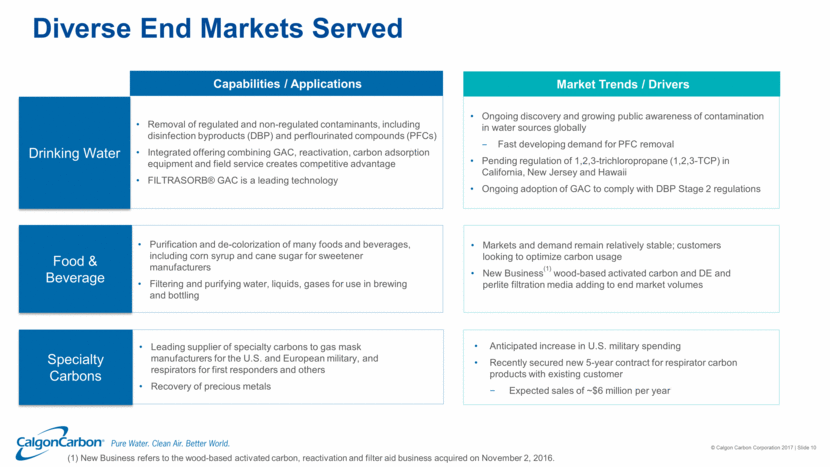
Diverse End Markets Served Filtration and purification of discharged gases by chemical, pharmaceutical and refining industries Innovative solution, FLUEPAC®, is treatment of choice for mercury emissions removal Activated carbon and DE filtration media products used for purification and / or separation of customers’ products Serve companies in various industries including chemical, oil & gas, and pharmaceuticals Demand tied to industrial production Initial signs of improving demand toward the end of 2016 Early indications in 2017 of improving economic conditions, including positive manufacturing and production index trends Industrial sector maintenance projects Price of natural gas Compliance with Mercury and Air Toxics Standards rule (MATS) requiring coal-fired power plants in the U.S. to control mercury emissions Expect to maintain ~30% share of 250-350 million std. lb. market Treatment of industrial wastewater streams Remediation of contaminated ground water / chemical spills Hyde GUARDIAN® UV disinfection equipment to prevent the transfer of invasive species between marine ecosystems Wastewater demand aligned with industrial production Ballast Water: 5-7 year retrofit opportunity expected to begin 4Q 2017 IMO Convention compliance, enters into force 9/8/2017 U.S. Coast Guard ballast water rule compliance (1) New Business refers to the wood-based activated carbon, reactivation and filter aid business acquired on November 2, 2016. Industrial Processes Environmental Air Environmental Water Capabilities / Applications Market Trends / Drivers
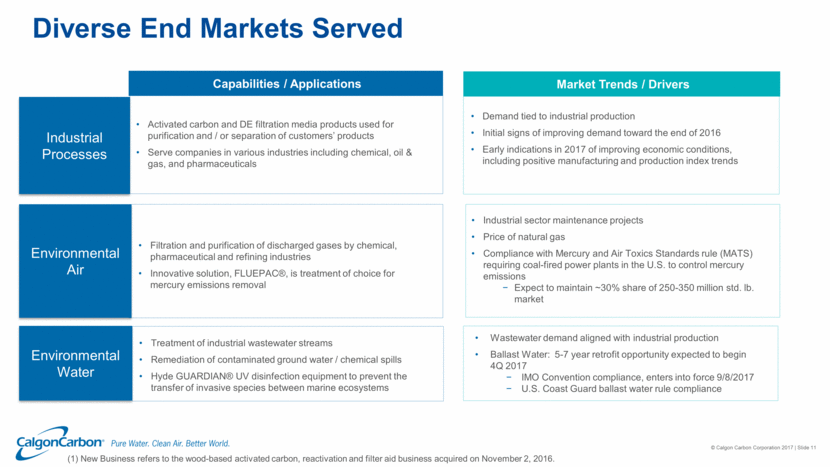
Income Statement Highlights Primary drivers of ($48) million sales decline from 2012-2016: Cumulative FX impact of ~($40) million Lower ballast equipment sales of ~($22) million Lower Japan sales of ~ ($17) million (excluding FX impact) Weak industrial sector demand in 2016 Offset by increases in sales related to the addition of the New Business of ~$12 million, mercury removal products of ~$9 million and North American municipal water activities of ~$8 million Gross margin improvement, 2013-2015, reflects 3-phase program to reduce costs, optimize virgin carbon plant production and expand capacity (1) Defined as net sales less cost of products sold (excluding depreciation and amortization) as a percentage of net sales. 562.3 547.9 555.1 535.0 514.2 0 140 280 420 560 700 FY 2012 FY 2013 FY 2014 FY 2015 FY 2016 Net Sales ($/M) 30.2 33.0 34.6 35.8 32.6 26.0 28.0 30.0 32.0 34.0 36.0 38.0 FY 2012 FY 2013 FY 2014 FY 2015 FY 2016 Gross Margin (1) (%)
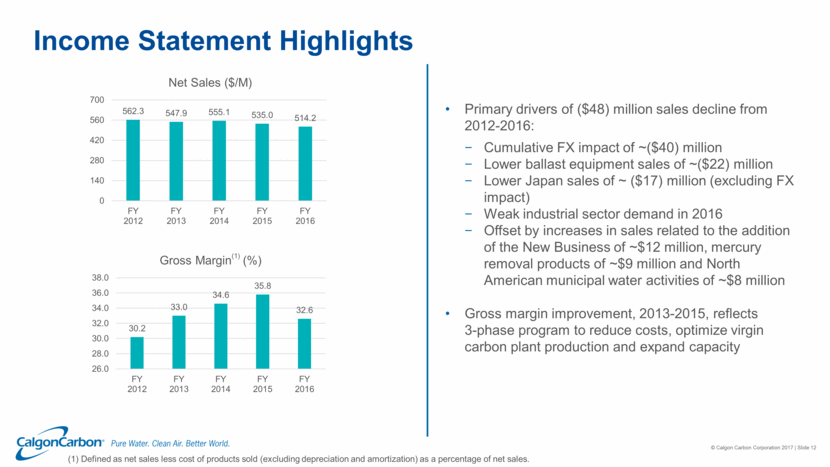
Cautiously optimistic about recovery in industrial sector demand Legacy business sales growth drivers: Potable water: PFC removal and other opportunities Awarded 20 PFC projects in North America in 2016, valued at ~$10.0 million Active opportunities >2x 2016 awards in both number and value Environmental air: mercury removal product sales New customers requiring hard-to-treat solutions and elevated natural gas prices Environmental water: ballast water treatment systems Anticipate higher equipment sales toward the end of the year assuming regulatory compliance remains on track New Business expected to contribute ~$100 million in sales Expect to generate more than $100 million in EBITDA Continue to focus on reducing costs and further improve operational and manufacturing processes to drive higher levels of profitability Integration of New Business and capture of expected synergies and benefits from projects 2017 Outlook and Priorities Sustain Leading Position in End Markets that Value High-Performing Products (1) New Business refers to the wood-based activated carbon, reactivation and filter aid business acquired on November 2, 2016.
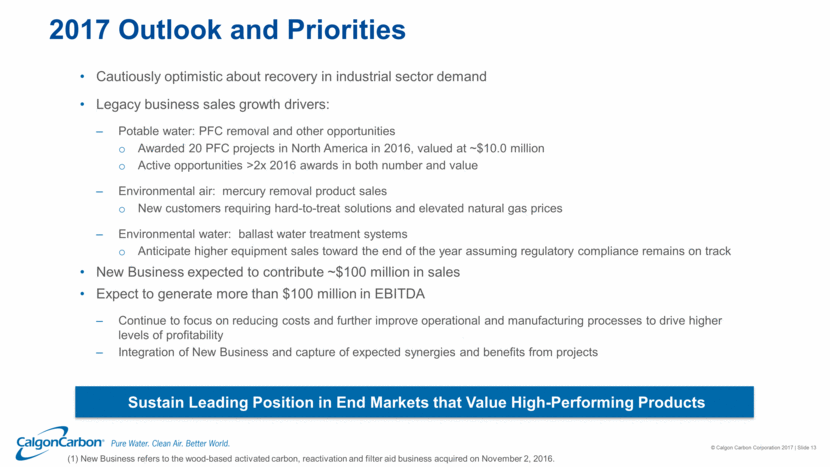
Longer-Term View -- Optimize Business Profitability Fiscal 2016 Long Term Target Gross Margin (1) Operating Expenses / Net Sales 32.6%(2) ~35.0% 20.5%(2) ~15.0% Capture expected acquisition-related cost synergies Continued cost control and reductions Complete New Business de-bottlenecking project Improved product / customer mix Manufacturing cost improvement / efficiencies / capacity leverage Increase EBITDA(3) Margin from 11.8%(2) for 2016 to Long-Term Target of ~20% Key Drivers Net sales less cost of products sold (excluding depreciation and amortization) as a percentage of net sales. Gross Margin includes $1.5 million (0.3% of net sales) of inventory-related purchase accounting costs. Operating Expenses / Net Sales includes $15.7 million (3.1% of net sales) of acquisition and project related costs. EBITDA Margin includes the $17.2 million (3.3% of net sales) total of $1.5 million of inventory-related purchasing accounting costs and $15.7 million of acquisition and project related costs. See GAAP to Non-GAAP Reconciliation Table in the Appendix.
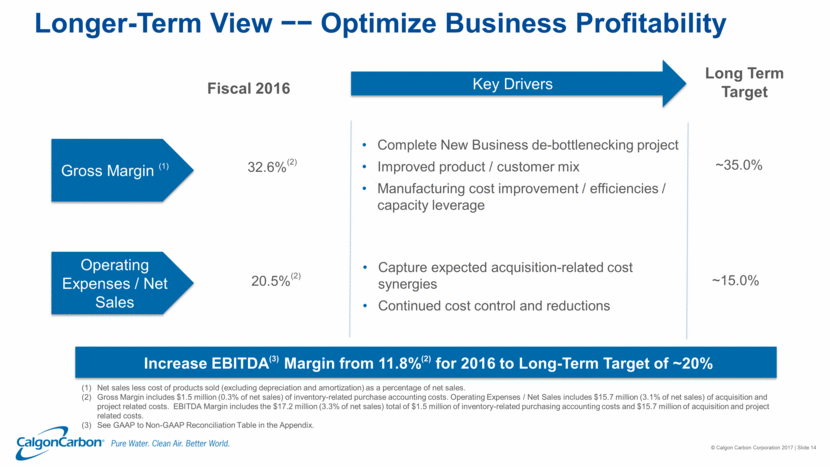
Strategic Multi-Year Value Creation Path Expand into complementary activated carbon segments Increase wood-based activated carbon capabilities to serve demand in North America and globally Build broader filtration media business Leverage and sustain market leadership Capture opportunities in new activated carbon applications Complete integration of New Business Fully realize integration synergies and benefits of de-bottlenecking project Optimize operating expenses Further increase operational efficiencies and plant productivity Strengthen Core Business Expand Business Opportunity Set
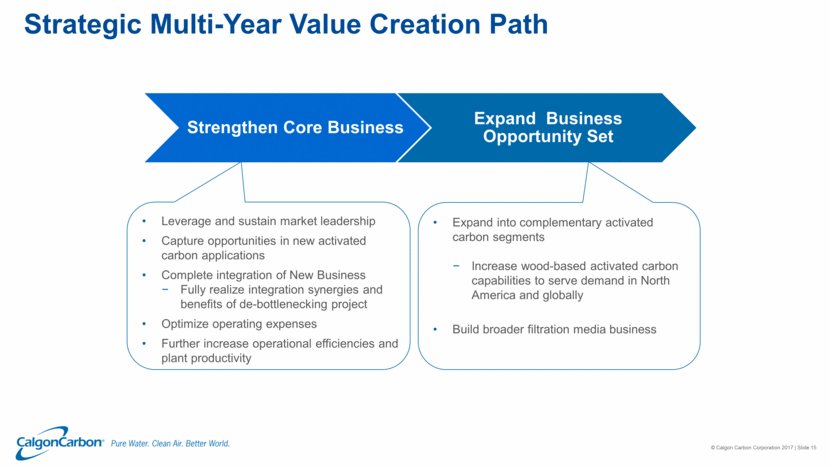
2012-2016 Avg. Annual Capital Allocation Growth capex enhanced productivity and increased virgin capacity by > 20 million lbs Acquired New Business for $154 million Returned $159 million to shareholders Increased leverage at Dec. 31, 2016 to ~2.25X expected 2017 EBITDA Future Capital Allocation Priorities Maintenance Expected growth in operating cash flow from addition of New Business and targeted profitability improvements Strong Cash Flow Generation Enhances Strategic Financial Flexibility Refurbish / expand Neville Island plant in 2017 Annual maintenance capex $25 to $30 million Growth De-bottleneck wood carbon plant in 2017 Increase wood-based carbon capabilities / capacity to serve demand globally Broaden adjacent filtration media capabilities Return Capital Reinstated dividend in 2015; $0.20 per annum Share repurchase program currently suspended; $64.1 million of remaining authorization Debt Service Required annual repayments on term loan Discretionary debt repayments 72.7 66.8 84.3 69.9 69.0 40 60 80 100 2012 2013 2014 2015 2016 Operating Cash Flow ($/M)
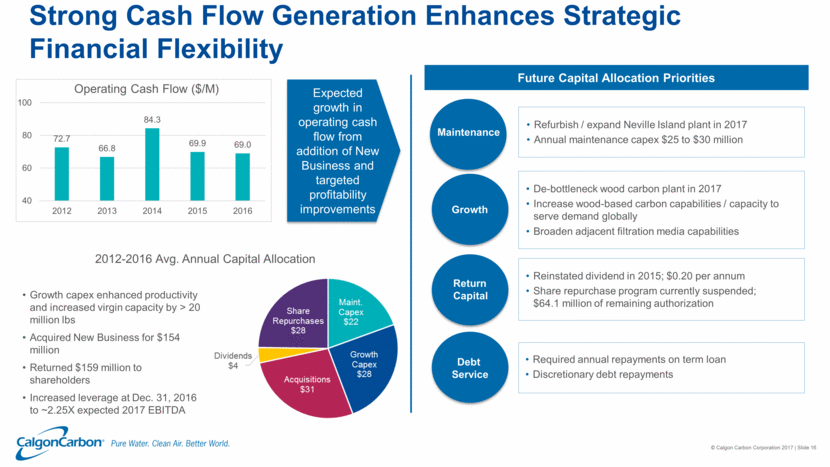
Securely Positioned in High-end Segments Focused on Improving Margins and Lowering Operating Expenses Strong Cash Flow Generation Enhances Strategic Financial Flexibility Attractive Opportunities to Extend into Adjacent Markets Established Global Market Leader in Activated Carbon On Track to Deliver Value Through Recent Acquisition Well Positioned to Benefit from Emerging Ballast Water Market Investment Highlights
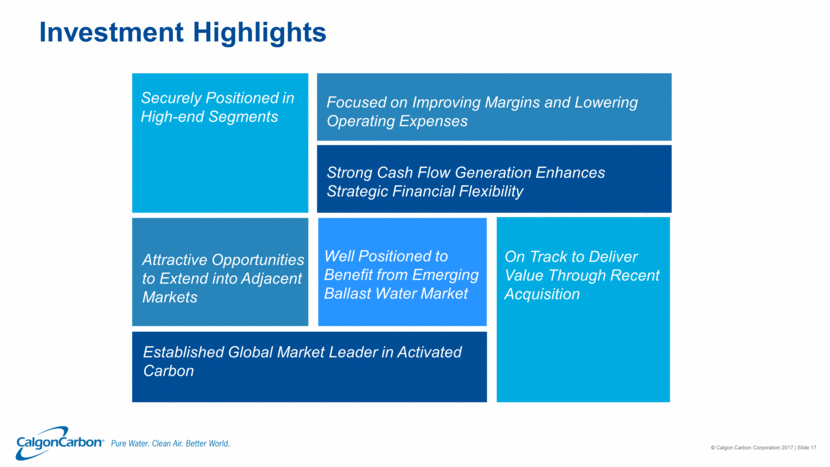
Appendix
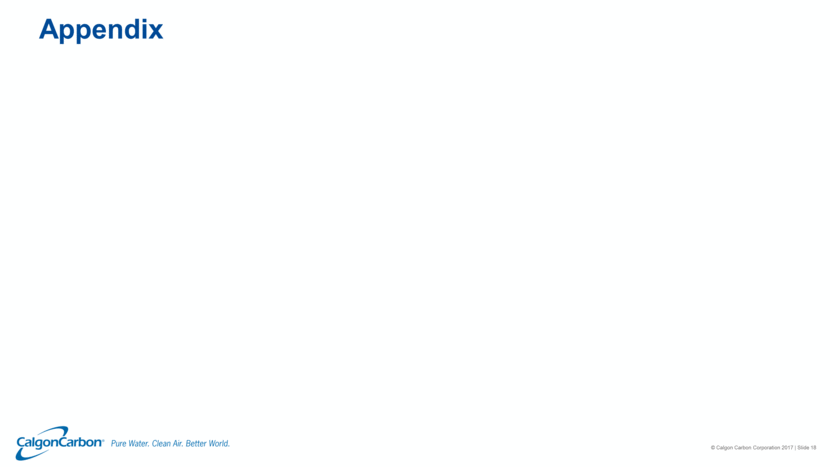
GAAP to Non-GAAP EBITDA Reconciliation ($/thousands) Year ended December 31, 2016 2015 2014 2013 2012 Net Income $ 13,797 $ 43,463 $ 49,370 $ 45,713 $ 23,272 Income tax provision 6,276 19,923 23,138 21,486 14,064 Interest expense 2,385 773 263 462 80 Interest income (99) (58) (77) (136) (35) Depreciation and amortization 38,070 35,453 30,470 28,938 26,320 EBITDA $ 60,429 $ 99,554 $ 103,164 $ 96,463 $ 63,701 Net sales $ 514,246 $ 535,004 $ 555,103 $ 547,939 $ 562,255 EBITDA margin (% of net Sales) 11.8% 18.6% 18.6% 17.6% 11.3%
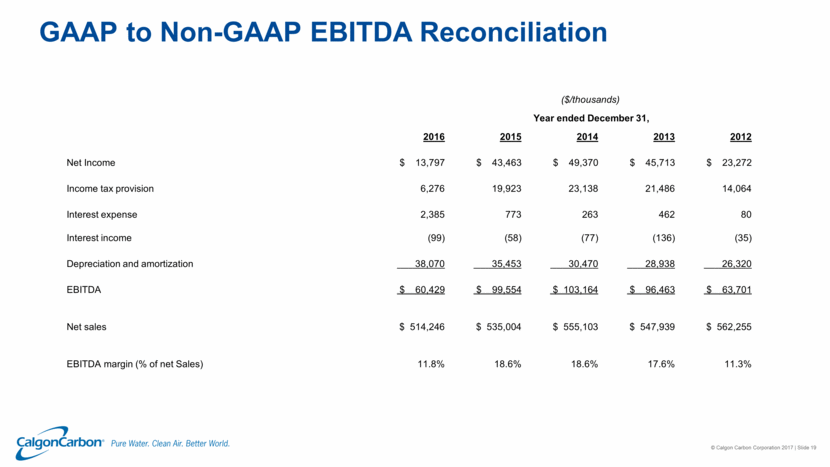
North American Drinking Water Market Drivers Ongoing discovery of contamination in water sources Barrier protection for vulnerable surface water sources Surface waters with high TOC levels having difficulty meeting DBP limits with chloramines Heightened consumer focus on water quality / safety CCC Solutions Currently Regulated: Taste & odor contaminants / compounds Stage 2 disinfection byproducts (DBPs) Trichloroethylene/tetrachloroethylene (TCE/PCE) Pending Regulation 1,2,3-Trichloropropane (1,2,3-TCP) Pending in California, New Jersey and Hawaii Potential for Future Regulation Perflourinated compounds (PFCs) Carcinogenic volatile organic compounds (cVOC) Stage 3 DBPs Endocrine-disrupting compounds (pharma / pesticides) Seasonal algal toxins Notable Contaminants / Issues of Concern TOC - Total Organic Compounds * - Company estimates Activated Carbon Reactivation Equipment US / Canada Market Potential Installed GAC ~ 4% CAGR * Lb’s (millions) 0 50 100 150 200 250 DBP (Stage 1 / 2) Non DBP
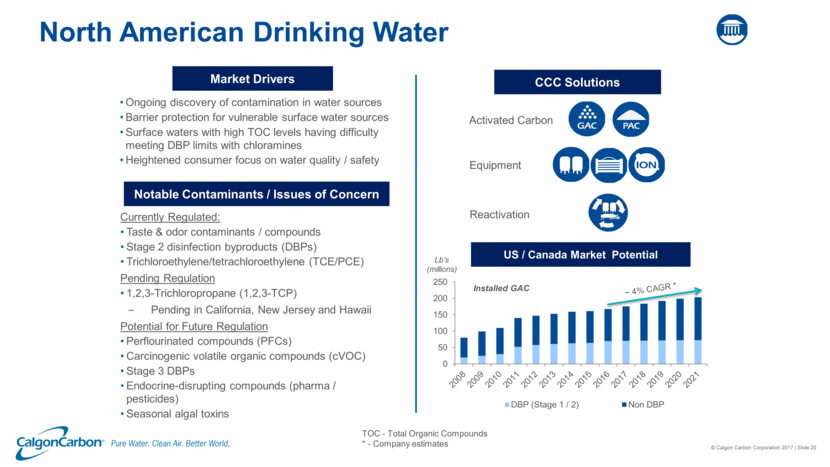
North American Drinking Water PFC Opportunity CCC Solution FILTRASORB® GAC is a proven technology Leading technology for removal of PFCs from drinking water and ground water sources FILTRASORB shown to outperform coconut in accelerated column tests > 15 years of experience at more than 20 municipal and industrial installations Economical solution that can be deployed quickly Spent GAC can be reactivated – safely – allowing for GAC reuse and destruction of adsorbed PFCs Recent successes: Hoosick Falls, NY: Temporary equipment/GAC municipal water solution; GAC for point of use solutions for private wells. Total of 20 new project awards in 2016; nearly 50 additional project opportunities under review Carbon adsorption equipment has been / will be an important part of the solution in most cases PFCs – Perfluorinated Compounds ppt – parts per trillion A combination of CCC equipment, GAC and field service support provides utilities an easy, effective, economical solution May 2016 – EPA established a Health Advisory Exposure Limit of 70 ppt; certain states evaluating adoption of lower limits.
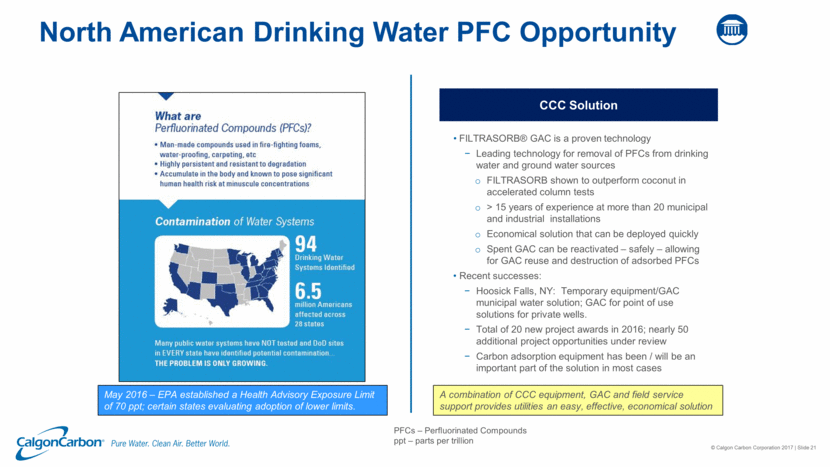
North American Drinking Water DBP Opportunity Background and Ongoing Opportunity for the adoption of GAC Municipal water utilities must disinfect water delivered to customers to comply with the Surface Water Treatment Rule which protects the population against harmful bacteria and viruses - - chlorine is the most commonly used disinfectant However, chlorine reacts with naturally occurring organic matter in raw water sources to form harmful compounds called disinfection by-products (DBPs); certain DBPs are regulated by Stage 1 and Stage 2 EPA regulations Some utilities have switched from chlorine to chloramine to avoid creating regulated DBPs; most have done this without a process to reduce the organic matter in the raw water sources; in addition, chloramine interacts with organic matter to create other potentially more harmful DBPs that are currently not regulated – could be subject to a future EPA rule (Stage 3 DBP) When the naturally occurring organic level in the water source is high, these utilities can have difficulty simultaneously complying with disinfectant requirements related to the Surface Water Treatment Rule and DBP levels related to the Stage 2 DBP rule GAC removes organic matter from water; prevents the formation of all DBPs and allows for the safe use of chlorine Longer-term Opportunity: Stage 3 DBP Rule Source: Management analysis Mid-term Opportunity: Compliance Issues 1/ Largest water systems that switched to chloramines to disinfect to meet Stage 2 DBP regulations; many more water systems have also switched States where certain water systems using chloramines are having difficulty complying with DBP Stage 2 regulations (per water quality reports, “do not drink” alerts) *** Total 5,420 330 55
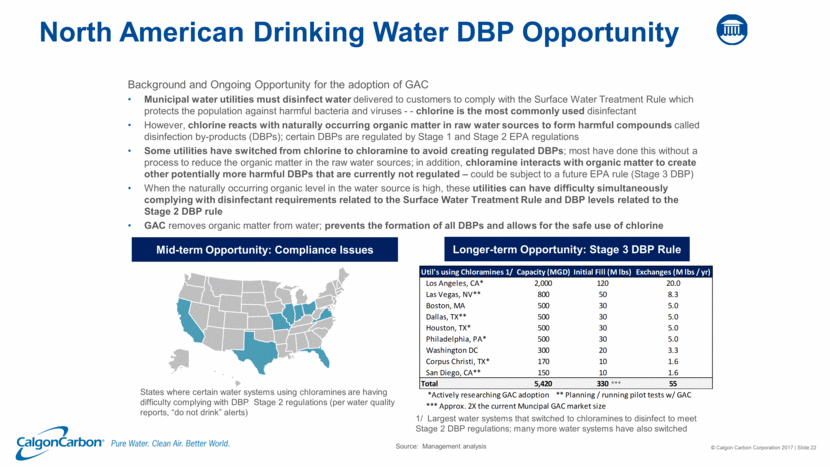
Mercury Removal In 2015 and 2016, existing U.S. State and Canadian Regulations were supplemented by the implementation of the U.S. EPA’s Mercury and Air Toxics Standards rule (MATS) MATS requires all coal-fired power plants in the U.S. to control mercury emissions; final extended compliance date was April 2016 Following a U.S. Supreme Court challenge in 2015, U.S. EPA issued a Final Supplemental Finding in April 2016 that MATS was appropriate, keeping MATS in place Approximately 300 coal-fired electric generating units (EGUs) equipped to treat mercury emissions with Powdered Activated Carbon (PAC) in North America Annual estimated PAC market size in 2017 of 250 million to 350 million “standard product” pounds * Calgon Carbon’s Advanced FLUEPAC® PAC Products Flexibility: Complete product line including advanced, patent protected products that deliver superior performance Lowest “total” mercury control cost / ash sale maintenance 50% to 70% less carbon to meet MATS requirement Dry Product – improves product flow / operational performance Compatibility / Superior Hg removal when dry sorbent injection (DSI) is utilized for SO2 or HCI control Expect to maintain 30% share of the value of the PAC market for treating mercury emissions in North America 2016 revenues totaled $45.1 MM 2017 revenues expected to increase > 10% vs. 2016 Q1 Revenues expected to exceed Q1 2016 revenues of $8.2 MM by at least 30% New contracts, higher natural gas prices Market Drivers CCC Solution * Company estimate
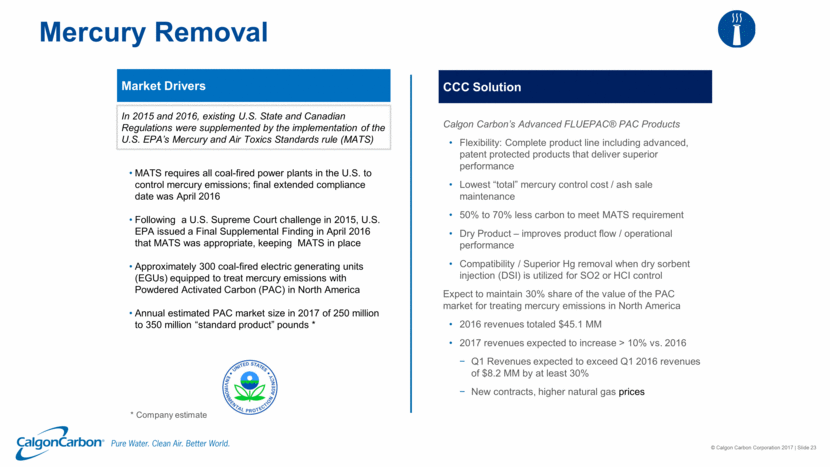
Ballast Water Treatment Prevent spread of invasive species (e.g. zebra mussels) Expected market size $18B to $28B – 64,000 ships * Regulations / Recent Developments IMO Convention Ratified on Sept. 8, 2016 Enters into force Sept 8, 2017 Estimate 66% to 90% of total expected market size to be impacted by IMO Convention with no impact from USCG regulation.* United States Coast Guard (USCG) Ballast Rule enacted June 2012; vessels subject to compliance as of Jan. 1, 2016 Dec. 2016 – First 3 systems granted Type Approval (TA) for USCG compliance > 11,500 vessel compliance extensions granted as of Dec 2016; not granting as liberally as previous to December TAs Q1 2017 ballast water discharge violation to result in a civil penalty Situation Hyde Marine Addresses the LARGE retrofit market with a SMALL system Effective reliable solution based on filtration and ultraviolet (UV) disinfection; simple, automatic operation Skid-mounted or modular-component system allows for optimal integration into new-build or existing vessels Can serve flow rates from 60 m3/h to 6000 m3/h in either a standard or multi-reactor system configuration. Over 450 Hyde systems sold since 2010 acquisition Type Approved (TA) for IMO Convention compliance Completed land-based testing toward gaining updated IMO certification Commencing USCG TA testing under USCG testing protocols in Mar. 2017; Expect to apply for USCG TA in Q4 2017 * Company estimates Recent developments leading to increased bid activity; expect to lead to sales growth in late 2017
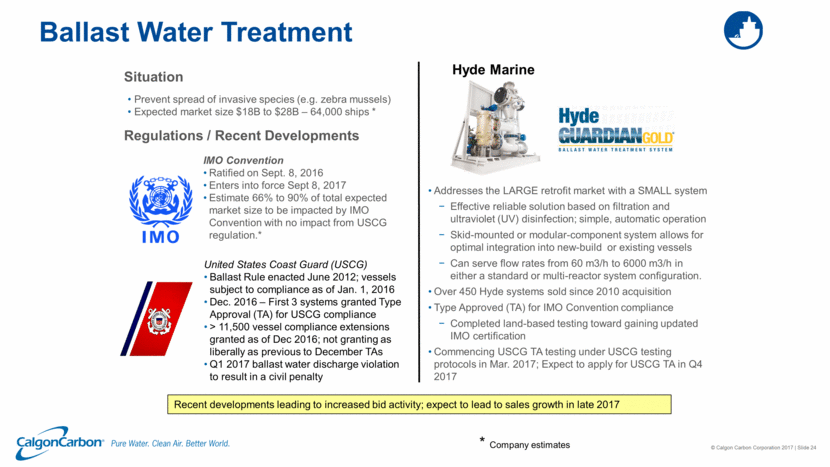
Lower costs than using virgin carbon Certified destruction of the adsorbed materials (which may be classified as hazardous) No landfill liabilities Lower cost than incineration Sustainability benefits Generates only 20% of the CO2 vs. the production of virgin carbon Assured supply of carbon Expert Field Service support and logistics Benefits Reactivation Sites Fukui, Japan Municipal, Industrial Suzhou, China Industrial, Municipal (conversion of muni kiln to industrial in process) Tipton, UK Municipal Feluy, Belgium Municipal, Industrial North Tonawanda, NY Municipal Pittsburgh, PA Industrial RCRA Columbus, OH Municipal, Industrial Catlettsburg, KY Industrial RCRA Gila Bend, AZ Municipal Blue Lake, CA (idle) Municipal Approximately 170 municipal water systems use Custom Municipal Reactivation (CMR) in North America Legnago, Italy Municipal Reactivation
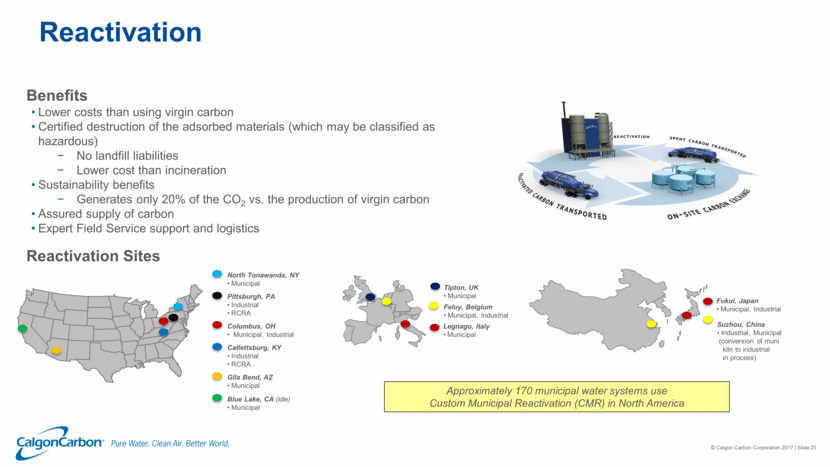
Dan Crookshank Director, Investor Relations & Treasurer Direct Dial: 412-787-6795 DCrookshank@calgoncarbon.com www.calgoncarbon.com For Additional Information:
